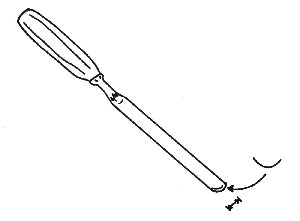

Hand Tools (includes chisel sizes and use)
On this list an "!"
precedes the most important items.
!Mallet - Round, 20 oz.
hard "rubber" w/ wood handle. Round wood mallets are
good too, a smaller or larger size might be to your preference,
whatever works best. Making a mallet on a wood lathe is a good project, experiment with different types of wood and sizes.
!Oil stones, water stones, sharpening stones, diamond stones, a leather strop, hard felt wheel, fancy electric wet stones, sharpening belts, etc. (work your way up gradually on these).
!Clamps, your strong and quiet partner (assuming you also have a wooden vice on your workbench), a carouselmaker's best friend, C-clamps, !"I" beam clamps (36" or 48" get four of same length), !1/2" and 3/4" pipe clamps (18", 24", 36", 48"), !wooden jaw clamps (Jorgensen, large size), !"pony" adjustable "C" clamps, etc.
!Chisels: all of these are not essential, get what you can, that will be fine. Others which I have not listed can be fine too, depending on your preference, keep chatting. I use the type with the little screw design on the shank (made in Germany), they are good, easy to sharpen carbon tool steel, there are other good makers too; I stay away from the stainless steel tools as they are hard to re-sharpen. The amount of curve (called the sweep # x) and chisel size (the width in millimeters, mm.) are indicated according to a regular system of numbers. Generally speaking, they start with a straight sweep, like most normal wood chisels, designated by a #1 and followed by the width in mm. The higher this first number becomes, the more pronounced the curve until it gets into the higher numbers when specially curved and bent chisels are being described such as parting chisels, fishtails, reverse curve scoops etc. This sweep number is always given first. The second number is the width of the blade on the chisel in millimeters. Chisel makers not using this universal system should be treated with caution as they might not be making the chisels you want to have.
!One set of Marples (or equivalent) straight chisels 1/4" thru 1½", the long handles and shank on these are a must, the short handled hardware store carpenter's variety are not recommended*, if you can find a nice extra long, wide and heavy "slick" type chisel get it.
#2/20mm
!#3/35mm
!#4/60mm (fishtail)
#4/30mm
#4/18mm
!#5/14mm
!#6/12mm
#6-36/18mm (fishtail)
#8/10mm
#8-18/25mm
!#8/20mm
#41/8mm
!#41/12mm (get this one if you can afford only one #41 type parting chisel)
#41/22mm
Canvas (or leather) roll-up tool pouch and tool box to protect and organize tools. Sharpened chisel blades should never touch metal, i.e. another chisel or tool etc. The most dangerous chisels are the dull ones, you have to push and hit them harder to get anything done, they don't aim well, they can cut you bad.
When using a chisel without a mallet, you can
push right through the wood or even blow down hard on the wood
holding the chisel in your hand (this is for the real avid hand carver). When doing this, you usually hold the chisel with your writing hand on the handle
and the other hand on the metal chisel stock often times quite
close to the blade. This method is not quite as accurate as when using a mallet. When using a mallet, continue holding the
steel chisel shank almost loosely with your non-writing hand and hold the mallet
in your writing hand.
When carving with the mallet, you don't need to
have a tight grip on the shank, just let your relaxed grasping hand be a guide for it as the
mallet blows on the handle and steers the chisel through the wood.
By not gripping the handle tightly your hands won't get as fatigued.
For close work, use the both hands on the chisel technique, and
give the blade a dual motion, the gentle
push from your writing hand on the end of the handle and a sideways
sweeping motion with your wrist on your other hand holding the steel shank.
This combined motion makes a diagonal cut on the wood which acts
somewhat like a saw blade cutting through. This technique is especially good
on areas of end grain or when working with really soft wood such as cedar.
The regular tools, such as; a plane, a hammer,
a small hammer shaped mallet, a screwdriver, a straight edge,
a square, dowel sets, a tape measure, some saws, large dividers (for measuring and balancing the size of parts on one side of a carving to those on the other),
and more,...the workbench is mentioned soon.

*Although, I built my first compete carousel in Chiapas, Mexico completely with one small set of hardware store Stanley chisels, a handheld circular saw, a handheld jig saw, a 3/8" hand drill, a hand planer, and a few pony clamps.